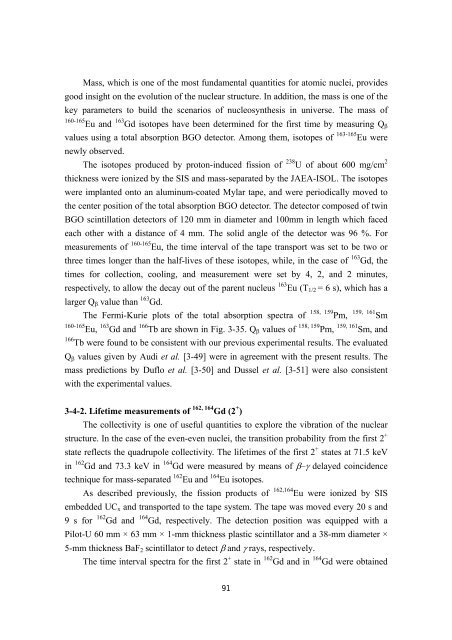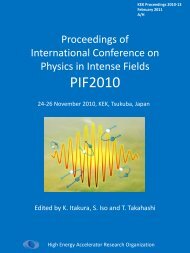TRIAC Progress Report - KEK
TRIAC Progress Report - KEK
TRIAC Progress Report - KEK
Create successful ePaper yourself
Turn your PDF publications into a flip-book with our unique Google optimized e-Paper software.
Mass, which is one of the most fundamental quantities for atomic nuclei, provides<br />
good insight on the evolution of the nuclear structure. In addition, the mass is one of the<br />
key parameters to build the scenarios of nucleosynthesis in universe. The mass of<br />
160-165 163<br />
Eu and Gd isotopes have been determined for the first time by measuring Qβ<br />
values using a total absorption BGO detector. Among them, isotopes of 163-165 Eu were<br />
newly observed.<br />
The isotopes produced by proton-induced fission of 238 U of about 600 mg/cm 2<br />
thickness were ionized by the SIS and mass-separated by the JAEA-ISOL. The isotopes<br />
were implanted onto an aluminum-coated Mylar tape, and were periodically moved to<br />
the center position of the total absorption BGO detector. The detector composed of twin<br />
BGO scintillation detectors of 120 mm in diameter and 100mm in length which faced<br />
each other with a distance of 4 mm. The solid angle of the detector was 96 %. For<br />
measurements of 160-165 Eu, the time interval of the tape transport was set to be two or<br />
three times longer than the half-lives of these isotopes, while, in the case of 163 Gd, the<br />
times for collection, cooling, and measurement were set by 4, 2, and 2 minutes,<br />
respectively, to allow the decay out of the parent nucleus 163 Eu (T1/2 = 6 s), which has a<br />
larger Qβ value than 163 Gd.<br />
The Fermi-Kurie plots of the total absorption spectra of 158, 159 Pm, 159, 161 Sm<br />
160-165 163 166<br />
Eu, Gd and Tb are shown in Fig. 3-35. Qβ values of 158, 159 Pm, 159, 161 Sm, and<br />
166<br />
Tb were found to be consistent with our previous experimental results. The evaluated<br />
Qβ values given by Audi et al. [3-49] were in agreement with the present results. The<br />
mass predictions by Duflo et al. [3-50] and Dussel et al. [3-51] were also consistent<br />
with the experimental values.<br />
3-4-2. Lifetime measurements of 162, 164 Gd (2 + )<br />
The collectivity is one of useful quantities to explore the vibration of the nuclear<br />
structure. In the case of the even-even nuclei, the transition probability from the first 2 +<br />
state reflects the quadrupole collectivity. The lifetimes of the first 2 + states at 71.5 keV<br />
in 162 Gd and 73.3 keV in 164 Gd were measured by means of β–γ delayed coincidence<br />
technique for mass-separated 162 Eu and 164 Eu isotopes.<br />
As described previously, the fission products of 162,164 Eu were ionized by SIS<br />
embedded UCx and transported to the tape system. The tape was moved every 20 s and<br />
9 s for 162 Gd and 164 Gd, respectively. The detection position was equipped with a<br />
Pilot-U 60 mm × 63 mm × 1-mm thickness plastic scintillator and a 38-mm diameter ×<br />
5-mm thickness BaF2 scintillator to detect β and γ rays, respectively.<br />
The time interval spectra for the first 2 + state in 162 Gd and in 164 Gd were obtained<br />
91













